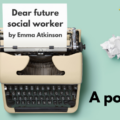
Would you invite journalists to shadow and report on your social work team?
- Yes, it would help improve public understanding of the profession (51%, 33 Votes)
- It would depend on the journalists and what they were witnessing (32%, 21 Votes)
- No, it would risk more misreporting of social work (17%, 11 Votes)
Total Voters: 65
At the end of May, four journalists from the Community Care team spent a day shadowing practitioners at Wandsworth children’s services, to understand what it’s really like to be a social worker.
Showcasing the complex, emotional, rewarding work social workers do every day is one of the main reasons we launched our Choose Social Work campaign in June..
So, here it is: home visits, direct work, family therapy, unit meetings, genograms, small wins, difficult decisions, risk, trauma, public transport. And snacks – never forget the snacks.
9am – home visit
By Sharmeen Ziauddin
Having never witnessed a home visit in action, I was excited that my day at Wandsworth started with shadowing a visit to Kelly, a parent to four children.
It was 9am when Annie, the social worker, and I got on a bus to Kelly’s home. Luckily for us, it was a beautiful sunny day – I did wonder what these bus journeys and walks would be like in the depths of winter. But, as a Londoner, Annie uses public transport for all her visits.
Annie’s reason for visiting was to do a graded care profile for Kelly’s four-year-old boy. He and his siblings had been placed on child in need plans after their school raised some concerns regarding possible neglect.
The graded care profile is a tool, created by the NSPCC, to evaluate the quality of care parents provide for their children. Only trained practitioners can use it – it had just gone 9am and I had already learnt something.
Annie had obtained Kelly’s permission for me to attend the visit. But she was understandably anxious, and had invited her mother to be present too.
Kelly, her mum and Annie sat on the sofa, in front of the TV, which was on. I sat at the far end of the room, as Annie suggested, doing my best to fade into the background and not add to the anxiety.
The conversation started with Annie asking how Kelly was doing and how the children were, as they were at school that day. Her whole demeanour was friendly; if you hadn’t known she was there in her capacity as a social worker, you might have assumed Annie was one of Kelly’s friends.
She went through each question of the graded care profile with Kelly. Annie told me afterwards that she wouldn’t normally go into so much detail but, as Kelly had learning disabilities and was also quite shy, she needed a bit more prompting.
Every word that came out of Annie’s mouth was considered and thoughtful; she clearly really thought about the language she was using. Despite Kelly’s initial anxiety, she soon began to relax.
The visit lasted an hour, and they ended by booking in the next session. Kelly’s assessment was very positive and she scored many ones and twos on the profile (with five being the least safe).
Back at the office after another bus ride, Annie put the results of the graded care profile onto the child’s record, along with her notes and observations. I reflected on the thoroughness of the visit, and how much thought, time and planning went into it. There were several components to the profile, and this visit focused on just one.
10:30am – children’s practitioner
By Ruth Hardy-Mullings

Photo: Demianastur/Adobe Stock
Like Annie, Lauren – a children’s practitioner at Wandsworth – was off to do some work using the graded care profile, with Caitlin, a mother she had been working with for several months.
“I like to go into my visits with an intention or with a purpose, but I’m never fixed to the idea,” Lauren told me. “I’m mindful that families are complex and go through different things. And sometimes they’re not in a place where they can focus on that activity… sometimes they just need someone to lend an ear and help them to problem-solve and think through some of the difficulties that they’re having.”
As a children’s practitioner, Lauren’s role is to meet regularly with families who are involved with a social worker. Typically, Lauren will work with a family for around four to six months, but the family she was going to see that morning – Caitlin, her toddler and two older teenagers – had needed support for almost a year.
“Lots of my work has been parenting support for Caitlin,” Lauren said. “So, just helping strengthen some of the skills that she already has.”
For instance, in relation to the toddler’s physical health, Lauren had worked with Caitlin to agree a goal to provide a healthy diet. This was then broken down into really simple steps that Caitlin could do. “So [the toddler’s] given one unfamiliar food to try at each mealtime, and then again he’s offered a healthy snack throughout the day.”
Caitlin found these specific goals really helpful, Lauren said. “She pinned it up on her wall so she could refer back to it.”
Even though Lauren’s role is as a children’s practitioner, she was working with a few families where her sole role related to parenting. “Because, actually for the child to be happy and safe, a lot of the time we need to look at the system that they live in and their environment around them. And so a lot of the time it does come back to strengthening the skills that parents have.”
Lauren’s favourite work is with children and young people – she started off working in nurseries – so after she did her work with Caitlin, she wanted to make sure she dedicated some time to the teenage daughter, Skye, who wasn’t attending school.
“I designed an activity to do with [Skye] about trying to figure out what her goals are,” Lauren said. “I think at the moment she’s feeling quite hopeless, and doesn’t really know where to go next. So my main aim of this activity hopefully is to help her set some goals, and think a little bit more positively about how she can then get there.”
Lauren was also starting to think about and talk to the family about endings – the end of her working partnership with them, “and what that’s going to look like, and helping them to think about their onward journey and … what we’ve already achieved and what also they have to continue on their journey.”
As much as I dislike ending work because it means that, you know, I’m stepping away and it’s an end of an experience for both me and families, I think it’s sometimes nice when children say ‘Oh, I’m going to miss you’ … I think I see it as playing a small part in a child’s life.”
Lauren continued: “And this family have been known to children’s services for over 20 years. So their involvement and their experience of services has been quite negative. So I think that is a real strength that we’ve been able to, despite the family’s views, build that relationship.”
12pm – systemic consultation
By Kirsty Ayakwah
Stepping into my first systemic consultation felt, for me, what it must be like to sit in on a forensic police case.
The qualities associated with social work are most often compassion, warmth and kindness – particularly when working with children. In the room, the adjectives that came to my mind were investigative, accurate and impartial. There was a huge amount of empathy there too, and awareness that social workers are working with families at really vulnerable moments in their lives.
There were five people in the systemic consultation, and the focus was on supporting social worker Lizzie with some challenges she was experiencing in working with a mother, Mary, and her son. Mary sometimes didn’t turn up to appointments with Lizzie, who generally travelled a long way to these meetings. She was due to visit Mary again that afternoon, and was concerned that she wouldn’t show.
Lizzie drew a genogram on the white board in the room, to fully understand the family’s background and the people who were involved in their lives.
Cue cards with picture symbols were used to help explore the best approaches to support the family. Elements of systemic practice were used, highlighting strengths within the family that could lead to them taking greater control and bringing lasting change to their lives.
After the session, I spoke to the family therapist, George. She provides therapy directly to families and works alongside social workers and practitioners to support their work, developing their skills in systemic practice.
The aim is for social workers to develop their expertise in using systemic skills and put these into practice in their assessments and statutory visits.
“That way they can build relationships a lot faster that initiate change and help families find the solutions for themselves,” George said.
She explained that social workers were generally working with traumatised families. Sometimes that trauma was intergenerational; at other times, it was connected to a specific event the parent had experienced. This could then manifest in the child’s behaviour.
“I like to say that their children are bringing them [the parents] to the service because somewhere they recognise that their parent needs a bit of extra support.
“And ‘acting out’ or antisocial behaviour might just be the way accessible to them to bring their parent or their family [to our attention] for extra help. Because children don’t always have the tools or knowledge to make change.”
She added: “Lasting change for an individual or family does not come from changing a behaviour. Instead, it comes from changing the belief system behind that behaviour. When this is achieved, with the support of a social worker, lasting change continues even when services are no longer involved with the family.”
Achieving this lasting change and making a difference was why George wanted to work in the social work sector.
“Working with the autonomy I have allows me to be as creative as possible; to try different ideas and adapt these ideas because families are not one-dimensional”.
2pm – child in need review
By Anastasia Koutsounia

Photo: Jacob Lund/Adobe Stock (posed by model)
In the council conference room, the atmosphere was almost festive.
The team manager, Shantelle, was celebrating. The mother, Pooja, a survivor of domestic abuse, smiled through the laptop screen. Because of the positive changes Pooja had made over the past two years, her children were no longer at risk of harm and were now being supported as children in need.
Other than Shantelle, the meeting also included the new lead social worker, representatives from the children’s school and the NHS, and a domestic abuse practitioner. The professional network had worked tirelessly with Pooja over the past two years to support her to recognise coercion and control in her relationship, and secure a better home environment for her children.
Shantelle’s warm and positive manner kept Pooja at ease – the trust she had nurtured was evident, and her compassion went hand in hand with questions that left no stone unturned. I was struck by her attention to detail, her ability to remember conversations from previous direct work with the children, no folder of notes in sight.
What has stayed with me until now, however, was a simple question about counselling sessions that had been arranged for Pooja.
“Is this purposeful for you?”, asked Shantelle, having previously been told that Pooja wasn’t getting much out of it.
I asked Shantelle later about her choice of words. For her, it was simple – she wasn’t interested in ticking boxes that weren’t helping. The plan had to be family-focused and that sometimes meant adding or even taking away services.
“I thought we should have that conversation,” Shantelle said. “Because if you’re going just for the sake of going or because the professionals are telling you, you will not get anything out of it.”
In that room I also got another important lesson – an outcome is seldom perfect. Pooja looked tired, the room was in slight disarray and, behind, her small children were jumping around and shouting her name. The school had also reported them being late to school a few times.
Parenting is not perfect, Shantelle told me, but as long as the children are healthy and safe, it doesn’t have to be. Pooja had made such progress that Shantelle was confident children’s services would be able to step out of the family’s life. It felt like a win.
3pm – unit meeting
By Sharmeen Ziauddin

Photo: istetiana/Fotolia
The two-and-a-half-hour unit meeting I attended in the afternoon was a real eye-opener. Present were three Frontline student social workers who already worked with families, a practice tutor, a new starter and the team manager. And lots of snacks!
After the team manager, Shantelle, had asked everyone how they were, Alex, one of the students, presented his dilemma. He had drawn a genogram showing the key people involved in the life of the family he was working with.
He then spent 10 minutes explaining the dilemma he was facing. The rest of the team discussed the dilemma and gave their hypotheses. Alex was able to listen to the team’s reflections and take any useful ideas forward with the team manager
Alex and Shantelle have been working with a mother, Harriet, for over six months (as Alex is still a student, Shantelle is the lead social worker for the family). Harriet has an older child not in her care due to alcohol misuse and mental health problems. She now has a newborn baby, Willow, with whom she is living with in a mother and baby unit, as agreed by the family court in public law proceedings.
Alex’s dilemma centred around the decision to be made when the placement in the mother and baby unit was over. Should Harriet be supported to live in the community with her child? Would she be able to manage this? What would be the impact of her mental ill health on her care of Willow? Would she been able to adapt to Willow’s changing development needs? What if she began to drink large amounts of alcohol?
One of the hypotheses his fellow students raised was that perhaps what was playing on Alex’s mind – because he was a student and learning – was the fear of something bad happening and the burden of risk he was carrying. This family’s situation was complex and the decisions facing the network and court were significant and could be life-changing for Willow and Harriet. On top of this, the climate of media hostility towards social workers and recent high-profile serious cases could be adding extra pressure on Alex to make the right decision.
In response to this, the practice tutor talked through Barry Mason’s theory of ‘safe uncertainty’ as a way to hold risk and remain comfortable with not knowing everything. And I found it moving to hear Shantelle and the practice tutor emphasise that when social workers work with families, they don’t hold decision making alone. Social workers are part of a multi-agency team, with schools, police, health and mental health all playing their part and sharing decision making.
The day ended with me being in absolute awe of the social workers I met. The decisions, the effort, the planning that goes into their work is phenomenal and cannot be understated. We only hear of the bad stories in the mainstream news but we never hear about the children and families social workers help.”
Choose Social Work
By Ruth Hardy-Mullings
Our day in Wandsworth showed me how necessary our Choose Social Work campaign is.
There has been a consistently negative public perception of social work for as long as Community Care has been around. Whenever there is a high-profile case – and these are almost always child protection cases – it is social workers who are held to account, named and blamed for what has gone wrong.
But social workers do not work in isolation. As Shantelle said, health, schools, police and other agencies are all involved.
By the very nature of your jobs, social workers have to make complex and difficult decisions. But what has stayed with me from our day in Wandsworth is the amount of thought and reflection that went into every one of those decisions, the care that was taken with language and the total absence of judgment of the families.
Thank you to all the social workers, practitioners and managers at Wandsworth, and the families they work with, who generously and bravely gave up their time to allow four journalists to spend the day with them.
All names and identifying details have been changed






 Family help: one local authority’s experience of the model
Family help: one local authority’s experience of the model  ‘I spent the first three months listening’: how supportive leadership can transform children’s services
‘I spent the first three months listening’: how supportive leadership can transform children’s services  How senior leaders in one authority maintain a culture of excellence
How senior leaders in one authority maintain a culture of excellence  How staff support ensures fantastic outcomes for children and families
How staff support ensures fantastic outcomes for children and families  Workforce Insights – showcasing a selection of the sector’s top recruiters
Workforce Insights – showcasing a selection of the sector’s top recruiters 

 Facebook
Facebook X
X LinkedIn
LinkedIn Instagram
Instagram
Comments are closed.